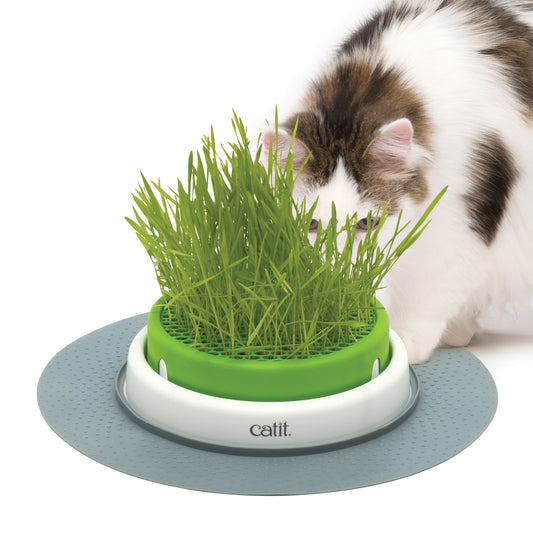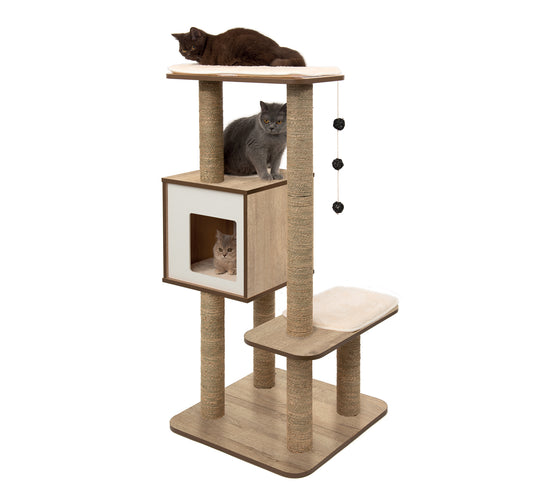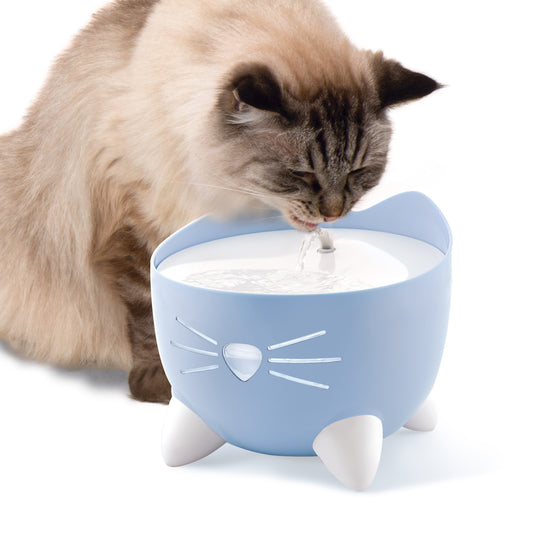All About Cat Grass: Benefits, Safety, and Growing Tips
Discover the benefits of cat grass for feline health, and learn how to grow and maintain it with Catit’s products.
What is Cat Grass?
Cat grass refers to several types of grass that are safe and beneficial for cats to consume. Contrary to the common name, cat grass isn't just one type of plant but can include wheatgrass, barley grass, oat grass, or rye grass. These grasses are rich in nutrients and provide a natural source of fiber, which is essential for a cat's digestion.
Why Does My Cat Eat Grass?
Cats eat grass for a variety of reasons that are beneficial to their health and well-being. One of the primary reasons is digestive aid. Grass acts as a natural laxative, helping to move hairballs and other indigestible items through the cat's digestive tract. The roughage in grass can also help to clear out any buildup in their stomach, promoting regular bowel movements.
Moreover, the act of eating grass can trigger a cat's vomiting reflex, allowing them to expel unwanted substances from their stomach. This might sound concerning, but it's a natural process for cats. They instinctively know when they need to cleanse their system, and eating grass is a safe way for them to do so.
Beyond digestive benefits, eating grass also satisfies a cat's need for certain nutrients. Grass contains folic acid, a vitamin essential for a cat’s bodily functions. Folic acid helps in the production of hemoglobin, the protein that moves oxygen in the blood, which is vital for your cat's overall health.
Behaviorally, cats are instinctual hunters, and eating grass can be linked to their ancestral diet in the wild. In nature, cats consume their prey whole, including the stomach contents of herbivorous animals, which often contain grass. Therefore, domestic cats might be driven by an inherent need to consume grass as part of their natural diet.
How to Grow Cat Grass
Growing cat grass is an easy and rewarding process that can greatly benefit your feline friend. Here’s a more detailed guide on how to cultivate this nutritious plant at home using products like the Catit Senses Grass Planter and Catit Senses Cat Grass Kit.
Choosing the Right Seeds
Cat grass can be grown from various seeds, including wheat, barley, oat, and rye. Each type offers different nutrients, so you might want to try a few and see which one your cat prefers. The Catit Senses Cat Grass Kit provides a blend of seeds specially selected for their nutritional value and palatability for cats.
Preparing the Container
Select a container that is wide and stable to prevent tipping when your cat nibbles on the grass. The Catit Senses Grass Planter is designed with a grid cover to prevent cats from digging in the soil and making a mess. It also ensures even growth of the grass, making it accessible for the cat to eat.
Planting the Seeds
Fill your container with a quality potting mix, leaving some space at the top. Sprinkle the seeds evenly over the soil surface, ensuring they are not too crowded. Cover the seeds with a thin layer of soil to protect them and retain moisture.
Watering
After planting, water the seeds gently but thoroughly to moisten the soil. The goal is to keep the soil moist but not waterlogged, as too much water can lead to fungal growth and root rot. The Catit Senses Grass Planter often comes with instructions on proper watering techniques to ensure optimal growth.
Providing Light and Warmth
Place the container in an area that receives indirect sunlight. While cat grass doesn’t require intense sunlight, it does need light to photosynthesize and grow. A windowsill or a spot with bright, indirect light is ideal. Warmth is also crucial for germination, so keep the container in a warm spot if your home is cool.
Monitoring Growth
Cat grass grows quickly, and you should see sprouts within a few days. Ensure the grass is not growing too densely, as this can lead to mold development. If necessary, thin the grass slightly by gently pulling out excess sprouts.
Maintenance
Once the grass reaches a few inches tall, it’s ready for your cat to enjoy. Continue to water it regularly to keep the soil moist and trim the grass if it becomes too long. This will encourage new growth and prevent the grass from becoming too tough for your cat to eat.
Replanting
Cat grass is not a permanent plant and will need to be replanted every few weeks to ensure a fresh supply. Over time, the nutrients in the soil will be depleted, and the grass may start to yellow and die. Regularly starting a new batch will ensure that your cat always has access to fresh, nutritious grass.
How to Care for Cat Grass
Caring for cat grass involves regular watering and ensuring it receives adequate sunlight. Avoid overwatering, as this can lead to mold growth. If the grass becomes too long, trim it to maintain a manageable height for your cat to nibble on. The Catit Senses Cat Grass Kit is an excellent option for cat owners, as it includes everything needed to grow healthy cat grass, along with instructions for proper care.
Why is Cat Grass Beneficial for Cats?
Cat grass is not just a whimsical treat; it plays a crucial role in a cat's health and well-being. Here's a deep dive into all of its benefits:
Nutritional Value
Cat grass is rich in essential nutrients that are beneficial for cats. It contains vitamins such as A and B, minerals like iron, and amino acids, which are vital for maintaining a healthy metabolism. The presence of folic acid in cat grass is particularly important as it aids in the production of hemoglobin, the molecule in blood cells that carries oxygen throughout the body, ensuring that your cat’s organs function optimally.
Digestive Health
One of the most significant benefits of cat grass is its contribution to a cat's digestive health. The fiber in the grass helps to stimulate digestion and assists in the smooth passage of hairballs and other ingested matter through the gastrointestinal tract. This can prevent the formation of hairballs, reduce constipation, and alleviate symptoms of indigestion.
Behavioral Enrichment
Chewing on grass is a natural behavior for cats, providing them with psychological satisfaction and helping to keep boredom at bay. For indoor cats, especially, access to cat grass can mimic the outdoor environment and fulfill their instinctual desires to graze. This can lead to improved mental well-being and reduced stress levels.
Detoxification
Eating grass can also serve as a form of self-medication for cats. The act of chewing and ingesting grass can help cats to expel indigestible matter, such as hairballs or bones, by inducing vomiting. This natural purging process helps them to clear their digestive tract of any irritants or blockages.
Alternative to Toxic Plants
Providing cat grass can also steer your feline friends away from potentially toxic houseplants. Cats may chew on household plants out of curiosity or a desire to nibble on something green. By offering them a safe and healthy alternative like cat grass, you can prevent the risk of poisoning and ensure they satisfy their cravings harmlessly.
Dental Health
Chewing on the tough blades of grass can also help in maintaining good dental health. It helps in cleaning the teeth, massaging the gums, and can reduce the buildup of tartar and plaque.
Improved Hydration
While not a primary water source, the moisture content in fresh cat grass can contribute to the overall hydration of your cat, especially for those that may be reluctant to drink adequate amounts of water.
Safety Considerations for Cat Grass
While cat grass is a beneficial addition to your cat's diet, it's important to consider safety to ensure that this green treat remains a healthy choice. Here are some key safety tips to keep in mind:
Regular Inspection
Check the cat grass regularly for signs of mold, pests, or disease. If you notice any unhealthy changes in the grass, such as yellowing leaves or a musty smell, remove and replace it to prevent your cat from ingesting something potentially harmful.
Avoid Overeating
While cat grass is safe for cats, consuming too much can lead to digestive issues like vomiting or diarrhea. Monitor your cat’s intake of grass and limit access if they tend to overindulge.
Introduce Gradually
If your cat has never had cat grass before, introduce it slowly into their diet. This allows you to monitor their reaction and ensure they don’t have any adverse responses.
Cat grass is more than just a treat for your cat; it's a vital part of their health and well-being. By understanding what cat grass is, why cats need it, and how to properly grow and care for it, you can ensure your feline friend maintains a healthy and balanced diet. Catit's specialized products make it easier to provide your cat with fresh, nutritious cat grass, supporting their digestion and keeping them away from harmful plants. Embrace the natural benefits of cat grass and see the difference it makes in your cat’s health and happiness.


